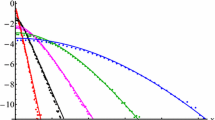Abstract
In the ordinary application of the time-lag method to the measurement of the diffusion coefficient of a gas passing through a plane sheet of an inert solid, the gas is pressurized on one side of the sheet and evacuated on the other. After decay of transients, the cumulative amount, Q(t), of gas diffused through the sheet in time, f, assumes the “time-lag” form, Q(t) = A(t − L). Measurements of the slope, A, and the intercept, L, can be used to determine the diffusion coefficient and the solubility of the gas in the solid. We have rederived this law for the case of a solid that is actively evolving this same gas at an arbitrary rate and have used it to predict the rate of outgassing of the solid upon standing. Practical applications of the theory include radioactive decay of minerals, rejection of plasticizers by plastics, and the decomposition of solid rocket propellants.
Similar content being viewed by others
References
W. Jost, Diffusion in Solids, Liquids, and Gases (Academic Press, New York, 1960), p. 44.
J. Crank, The Mathematics of Diffusion (Oxford University Press, London, 1957), p. 48.
J. McBreen, L. Nains, and W. Beck, J. Electrochem. Soc. 113, 1218 (1966).
M. Iino, Acta Metall. 30, 367 (1982).
T.N. Kompaniets and A.A. Kurdyumov, Prog. Surf. Sci. 17, 79 (1984).
A. S. Schmidt, F. Verfuss, and E. Wicke, J. Nucl. Mater. 131, 247 (1985).
R. Nishimura, R.M. Latanision, and G. K. Hukler, Mater. Sci. Eng. 90, 243 (1987).
S. K. Yen and H. C. Shih, J. Electrochem. Soc. 137, 2028 (1990).
R.N. Iyer and H.W. Pickering, Ann. Rev. Mater. Sci. 20, 299 (1990).
J. S. McBride, T. A. Massaro, and S. L. Cooper, J. Appl. Polym. Sci. 23, 201 (1979).
J. Springer and H. Brito, J. Appl. Polym. Sci. 24, 329 (1979).
S.J. Napp, W. Huang, and M. Yang, J. Appl. Polym. Sci. 28, 2793 (1983).
I.R. Bellobono, B. Marcandalli, E. Selli, and A. Polissi, J. Appl. Polym. Sci. 29, 3185 (1984).
K. Schaupert, D. Albrecht, P. Armbruster, and R. Spohr, Appl. Phys. A 44, 347 (1987).
M.M. Alger and T.J. Stanley, J. Appl. Polym. Sci. 36, 1501 (1988).
A. Higuchi and T. Nakagawa, J. Appl. Polym. Sci. 37, 2181 (1989).
E.A. Irene, J. Electrochem. Soc. 129, 413 (1982).
H. Meier, E. Zummerhackl, W. Hecker, G. Zeitler, and P. Menge, Radiochem. Acta 44–45, 239 (1988).
Ref. 1, pp. 300–304.
Ref. 1, pp. 314–319.
G. Arfken, Mathematical Methods for Physicists (Academic Press, New York, 1985), pp. 824([0-9]+)859.
Ref. 21, p. 831.
See, for example, A.L. Nelson, K.W. Folley, and M. Coral, Differential Equations, 2nd ed. (D. C. Heath and Co., Boston, MA, 1960), pp. 97–99.
Ref. 21, p. 400.
I. S. Gradshteyn and I. M. Ryzhik, Table of Integrals, Series, and Products (Academic Press, New York, 1980), p. 7, formula 0.234.5.
J. S. Chen and F. Rosenberger, J. Phys. Chem. 95, 10164 (1991).
H. Daynes, Proc. R. Soc. London A 97, 286 (1920).
Author information
Authors and Affiliations
Additional information
Also with the University of Alabama System Ph.D. Program in Materials Science.
Rights and permissions
About this article
Cite this article
Baird, J.K., Chen, JS. Theory of the time-lag diffusion method for the case of an outgassing solid. Journal of Materials Research 8, 1455–1461 (1993). https://doi.org/10.1557/JMR.1993.1455
Received:
Accepted:
Published:
Issue Date:
DOI: https://doi.org/10.1557/JMR.1993.1455




